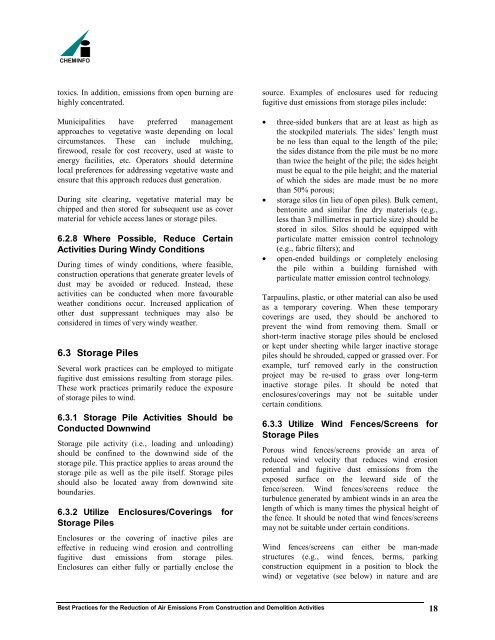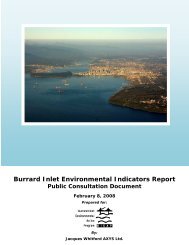Best Practices for the Reduction of Air Emissions From Construction ...
Best Practices for the Reduction of Air Emissions From Construction ...
Best Practices for the Reduction of Air Emissions From Construction ...
Create successful ePaper yourself
Turn your PDF publications into a flip-book with our unique Google optimized e-Paper software.
CHEMINFO<br />
toxics. In addition, emissions from open burning are<br />
highly concentrated.<br />
Municipalities have preferred management<br />
approaches to vegetative waste depending on local<br />
circumstances. These can include mulching,<br />
firewood, resale <strong>for</strong> cost recovery, used at waste to<br />
energy facilities, etc. Operators should determine<br />
local preferences <strong>for</strong> addressing vegetative waste and<br />
ensure that this approach reduces dust generation.<br />
During site clearing, vegetative material may be<br />
chipped and <strong>the</strong>n stored <strong>for</strong> subsequent use as cover<br />
material <strong>for</strong> vehicle access lanes or storage piles.<br />
6.2.8 Where Possible, Reduce Certain<br />
Activities During Windy Conditions<br />
During times <strong>of</strong> windy conditions, where feasible,<br />
construction operations that generate greater levels <strong>of</strong><br />
dust may be avoided or reduced. Instead, <strong>the</strong>se<br />
activities can be conducted when more favourable<br />
wea<strong>the</strong>r conditions occur. Increased application <strong>of</strong><br />
o<strong>the</strong>r dust suppressant techniques may also be<br />
considered in times <strong>of</strong> very windy wea<strong>the</strong>r.<br />
6.3 Storage Piles<br />
Several work practices can be employed to mitigate<br />
fugitive dust emissions resulting from storage piles.<br />
These work practices primarily reduce <strong>the</strong> exposure<br />
<strong>of</strong> storage piles to wind.<br />
6.3.1 Storage Pile Activities Should be<br />
Conducted Downwind<br />
Storage pile activity (i.e., loading and unloading)<br />
should be confined to <strong>the</strong> downwind side <strong>of</strong> <strong>the</strong><br />
storage pile. This practice applies to areas around <strong>the</strong><br />
storage pile as well as <strong>the</strong> pile itself. Storage piles<br />
should also be located away from downwind site<br />
boundaries.<br />
6.3.2 Utilize Enclosures/Coverings <strong>for</strong><br />
Storage Piles<br />
Enclosures or <strong>the</strong> covering <strong>of</strong> inactive piles are<br />
effective in reducing wind erosion and controlling<br />
fugitive dust emissions from storage piles.<br />
Enclosures can ei<strong>the</strong>r fully or partially enclose <strong>the</strong><br />
source. Examples <strong>of</strong> enclosures used <strong>for</strong> reducing<br />
fugitive dust emissions from storage piles include:<br />
• three-sided bunkers that are at least as high as<br />
<strong>the</strong> stockpiled materials. The sides’ length must<br />
be no less than equal to <strong>the</strong> length <strong>of</strong> <strong>the</strong> pile;<br />
<strong>the</strong> sides distance from <strong>the</strong> pile must be no more<br />
than twice <strong>the</strong> height <strong>of</strong> <strong>the</strong> pile; <strong>the</strong> sides height<br />
must be equal to <strong>the</strong> pile height; and <strong>the</strong> material<br />
<strong>of</strong> which <strong>the</strong> sides are made must be no more<br />
than 50% porous;<br />
• storage silos (in lieu <strong>of</strong> open piles). Bulk cement,<br />
bentonite and similar fine dry materials (e.g.,<br />
less than 3 millimetres in particle size) should be<br />
stored in silos. Silos should be equipped with<br />
particulate matter emission control technology<br />
(e.g., fabric filters); and<br />
• open-ended buildings or completely enclosing<br />
<strong>the</strong> pile within a building furnished with<br />
particulate matter emission control technology.<br />
Tarpaulins, plastic, or o<strong>the</strong>r material can also be used<br />
as a temporary covering. When <strong>the</strong>se temporary<br />
coverings are used, <strong>the</strong>y should be anchored to<br />
prevent <strong>the</strong> wind from removing <strong>the</strong>m. Small or<br />
short-term inactive storage piles should be enclosed<br />
or kept under sheeting while larger inactive storage<br />
piles should be shrouded, capped or grassed over. For<br />
example, turf removed early in <strong>the</strong> construction<br />
project may be re-used to grass over long-term<br />
inactive storage piles. It should be noted that<br />
enclosures/coverings may not be suitable under<br />
certain conditions.<br />
6.3.3 Utilize Wind Fences/Screens <strong>for</strong><br />
Storage Piles<br />
Porous wind fences/screens provide an area <strong>of</strong><br />
reduced wind velocity that reduces wind erosion<br />
potential and fugitive dust emissions from <strong>the</strong><br />
exposed surface on <strong>the</strong> leeward side <strong>of</strong> <strong>the</strong><br />
fence/screen. Wind fences/screens reduce <strong>the</strong><br />
turbulence generated by ambient winds in an area <strong>the</strong><br />
length <strong>of</strong> which is many times <strong>the</strong> physical height <strong>of</strong><br />
<strong>the</strong> fence. It should be noted that wind fences/screens<br />
may not be suitable under certain conditions.<br />
Wind fences/screens can ei<strong>the</strong>r be man-made<br />
structures (e.g., wind fences, berms, parking<br />
construction equipment in a position to block <strong>the</strong><br />
wind) or vegetative (see below) in nature and are<br />
<strong>Best</strong> <strong>Practices</strong> <strong>for</strong> <strong>the</strong> <strong>Reduction</strong> <strong>of</strong> <strong>Air</strong> <strong>Emissions</strong> <strong>From</strong> <strong>Construction</strong> and Demolition Activities 18
















